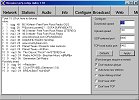|
WHAT
Peer to
peer audio streaming is an internet radio system with a twist. This
technology allows users to broadcast streaming MP3 audio to an unlimited
number of listeners. Developers hope to offer a version that
works with a 56k modem, but there are significant limits to bitrates
at that speed. Dial-up users generally connect for only short
periods of time, which can hamper the functionality of the streamcasts.
For now, this is primarily a broadband technology.
The peer to peer approach uses a tree/mesh network, where the originator
sends the signal to the next user. No server is required, and each listener
uses only enough bandwidth to listen and to pass the stream to the next
listener. Open source applications were initially published as a response
to the CARP royalty rates which would have closed most US net radio (this
explains the occasional pirate radio references).
It appears that
tree/mesh audio streaming has the potential to develop into
a useful low, cost mass broadcasting tool. If you are a net broadcaster,
or a Live365 refugee, you can use peer to peer to reach the world cheap.
There are dozens of stations, from trance to rock, and the software
required for listening to stations only takes a couple of
minutes to download and install.
Spend a few more minutes, and you could
even be a net broadcaster!
TOP
|
HOW
As of
this writing, the two most prominent open source applications
are Streamer and Peercast. Oddsock is an open source streaming
encoder, needed to provide the data stream that the other two applications
send out to the web. Most of the information available about this
new technology is available at the websites that offer these applications.
SCWIS UTOPIA PAGE •
STREAMER WEB SITE •
PEERCAST WEB SITE •
ODDSOCK WEB SITE
Because this is a brand new approach,
and because the software is open source, there are new versions released almost every week. Check
the developers' sites often to make sure you have the current
versions, and always, always, always read the latest release notes,
users' forums and help files. TOP
|
|
WHEN
LISTENING: Listening
is available right now, and listening to peer to peer audio streams
is quite easy, especially if you have broadband. If you have
a good dial-up connection you can still try it, but you should
read the forums for dial-up users before you go
too far. Streamer
is a very small download, and
is adware/spyware free. The set-up goes very quickly and it's
very easy to configure.
|

Click Here to View
|
The Streamer application will open your MP3 player and deliver
a copy of the audio stream to your sound card so you can enjoy
the music. Simultaneously, Streamer notifies the network that your IP is available to the next
listener who selects this stream. When a new listener comes on line and requests the stream
your PC sends it on. The new listener will become the next
available server, and will deliver the stream to any subsequent request.
BROADCASTING: The stream is up, and
the programs and hardware seem to be working well together.
THE SET UP
Software
Streamer 1.20
Winamp 2.81
Oddcast 10/22
Audiostocker
Much DFX
CDeX
(ext & enc) |
Hardware
PC PII 233
2 GB HD
64 MB RAM
Cable Modem
128 kbps limit
on upstream side
|
Statistics
Playlist
Over 80 songs
OGG source
24 kbps/22.05 KHz
MP3 Stream
24 kbps, Mono
(OK for Dial-up)
|
|
This is not for the squeamish, or those with
WinTel attention spans. This is not to discourage anyone,
it's just not a point and click operation. I have a stream up
and it sure seems cool when it works.
I am streaming MP3s, using Streamer and WinAmp with
the Oddcast, Much
DFX and Audiostocker plug-ins.
|
WHERE
Everywhere the internet
goes. This just might be an example of the continuing growth of
decentralized computing. Streams can originate from anywhere and
be received and re-served by any user. Physical proximity is a
non-issue. TOP
|
WHY
Because it is there. Because it uses bandwidth sparingly.
Because you can. Because it's free. Because it's open
source. POINT TO PONDER - The steam engine was first used in the
early 1700s. As a stationary power source the steam engine helped
start the industrial revolution. It wasn't until 100 years later
that the first locomotive put a steam engine on wheels. We now
know that railroads changed the whole world, almost overnight. Information
technology first implemented inter-connected computing machines in
the mid-twentieth century, fifty years ago. Anyone hear a digital
train whistle? TOP
This information comes from the websites
that are linked on this page, and is presented to provide the beginner
with some basic information. All rights are reserved by the original authors.
|
|
|

